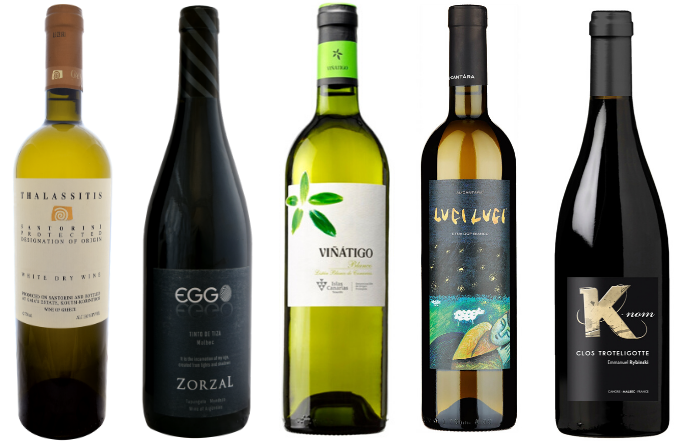Minerality is one of most-deployed words in the lexicon of the modern wine critic. It is also one of the most controversial – even the acknowledged experts find it difficult to agree what it is and how it behaves.
Last month two veterans of the wine industry, Hallgarten & Novum’s head buyer Steve Daniel, and scientist and wine writer Jamie Goode (above right and left), discussed the subject head-to-head, along with a selection of wines with mineral characteristics.
What causes minerality in wine?
“In the wine trade, we try to put our multi-modal sensations – of sight, sound and touch as well as smell and taste – into words,” says Goode. “When we use words like ‘cherries’ or ‘leather’, we’re not saying the wine actually contains these things, yet people assume when we talk about mineral taste in a wine that we are being literal.”
He went on to quote soil microbiologist Lydia Bourguignon: “Minerality is the perception of the rocks in the soil by the palate”. So does it come from the rocks? As well as some confusion over the very word ‘minerality’ – it can refer to a geological substance (granite, limestone etc) as well as to mineral nutrients in solution in soil (nitrogen, potassium, calcium and the rest) – scientists can’t agree as to whether it’s possible for rock and/or soils to transmit a ‘taste’ to finished wine.
People assume when we talk about mineral taste in a wine that we are being literal
Daniel is a champion of Greek wines; he believes the widespread limestone soils of Greece and most of her islands give the characteristic stony minerality that he so loves.
He has a similar ‘gut feeling’ with wines from volcanic regions, demonstrated by Gaia Wines’ Thalassitis from Santorini (one of Greece’s few volcanic islands), which, for Goode, is a ‘benchmark mineral wine’.
There is no soil here, yet the native grape Assyrtiko thrives – pre-phylloxera vines send their root systems deep through the pumice and sand in which they grow. It may be auto-suggestion, but the wine has a distinctive hit of pumice in texture and taste, along with the fleeting scent of a struck match. It also has the saltiness that so often characterises the minerality found in wines from coastal regions – the vines here get most of their moisture from sea mists. By total contrast, Clos Troteligotte’s ‘K-nom’ 2018, a funky, chunky Malbec/Merlot from iron-rich soils in Cahors, reminded Goode of “rusty nails and blood”.
It might be that soil chemistry has a more indirect effect, the panel suggested. Recent studies into gene science have found that vines planted from the same clones in different terroirs show differences in their gene expression (which determines the identity and ongoing function of each cell) while their genetic code remains identical. In other words, rather than actual minerals somehow being absorbed by the vine, it is the cells of the grape itself that produce the compounds we read as minerality.

Minerality is far more commonly found in white grapes than red, and is more prevalent in those with lean and precise profiles than those more fleshier and opulent. Red wines generally have denser fruit as well as the tannins and other flavours extracted from the skins, all of which overpower any sense of minerality the wines may hold.
Which brings us to what happens in the winery. The trend for reductive winemaking – where exposure to oxygen is kept to a minimum – gives us the lighter, more delicate wines that appeal to modern palates. “Big, oaky, aromatic wines don’t show minerality,” Goode says. “These days we prefer wines to be more ethereal, detailed and transparent: to show other things as well as fruit.”
Oak barrels aside, what do other fermentation and maturation vessels bring to the minerality party? The ovoid shape of concrete eggs keeps the fermenting liquid in constant circulation so the fine lees stay in suspension. This produces high levels of succinic acid, said to add a dry, persistent flavour that could be construed as a mineral note. As for clay amphorae, “they’re a way of making wine that has dimension, detail and complexity without the use of oak,” says Goode.
How do you describe minerality?
‘Stony’, ‘flinty’, ‘chalky’, ‘steely’ and ‘saline’ are among the words we use in the minerality lexicon, along with more nebulous terms such as ‘tautness’ and ‘grip’. So is it a flavour, aroma or texture, or is it a more elusive sensation that’s harder to pin down? It’s interesting that the word ‘terroir’ is about as recent as ‘minerality’ in the wine world, and one that is similarly elusive to define and explain.
This was a fascinating discussion neatly illustrated by its accompanying wines although, by its nature, it was ultimately inconclusive. “For me, minerality is a feeling,” Daniel concluded. “I just get a feeling for minerality in wine.”
You can browse wines with a tasting note of mineral in our reviews section, including this Karamolegos, Assyrtiko 34, 2017. Extremely οld vines Assyrtiko matured on the lees for 9 months. 10% of the blend has matured in third use oak. Pale lemon with a tight nose reflecting a unique terroir. Mineral, salty and smoky around a core of stone fruit. Structured and powerful with impressive definition and many layers on the palate.




